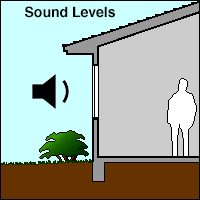
Measuring Performance: Sound
 The acoustical properties of windows are tied closely to technologies for infiltration control and to some degree to heat loss control. A side benefit to houses with tight, insulated windows is that they are dramatically quieter than homes with leaky windows. This reduction in noise transmission from outside to inside can be a major benefit for homes in noisy locations or to occupants who value privacy and quiet.
The acoustical properties of windows are tied closely to technologies for infiltration control and to some degree to heat loss control. A side benefit to houses with tight, insulated windows is that they are dramatically quieter than homes with leaky windows. This reduction in noise transmission from outside to inside can be a major benefit for homes in noisy locations or to occupants who value privacy and quiet.
The most significant step which can be taken to reduce sound transmission is to minimize air infiltration. Care should be taken to ensure the windows are installed properly to minimize infiltration between the wall and the window frame.
Beyond minimizing air infiltration and using double glazing, there a few steps that can be taken to further reduce direct sound transmission. These techniques are often custom and may add to the cost of the products. These include:
- Wide air/gas gaps between glazings (5/8-inch or greater instead of the 1/2-inch or less).
- Replacing air with argon or krypton between the glazings.
- A 1/4-inch exterior light with an inner light of different thickness (often laminated with 1/8-inch or 3/16-inch glass).
- Triple glazing with varying glass thicknesses including glass greater then 1/8-inch thick.
Both the National Fenestration Rating Council (NFRC) and the American Architectural Manufacturers Association (AAMA) have developed systems for rating the condensation resistance of fenestration products. AAMA 1503-09, Voluntary Test Method for Thermal Transmittance and Condensation Resistance of Windows, Doors and Glazed Wall Sections gives a dimensionless rating titled, Condensation Resistance Factor (CRF). This number ranges from 0 to 100; the higher the number the better a product resists forming condensation. AAMA provides the Condensation Resistance Factor Toolexit disclaimer to provide general guidance on suggesting a minimum CRF based on a project-specific set of environmental conditions. Obtaining a CRF for a window system, a physical test must be performed.
NFRC 500-2010, Procedure for Determining Fenestration Product Condensation Resistance Valuesexit disclaimer determines Condensation Resistance (CR) is expressed as a number between 1 and 100 is based on computer simulations